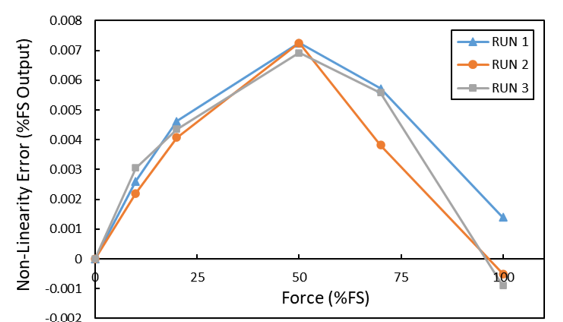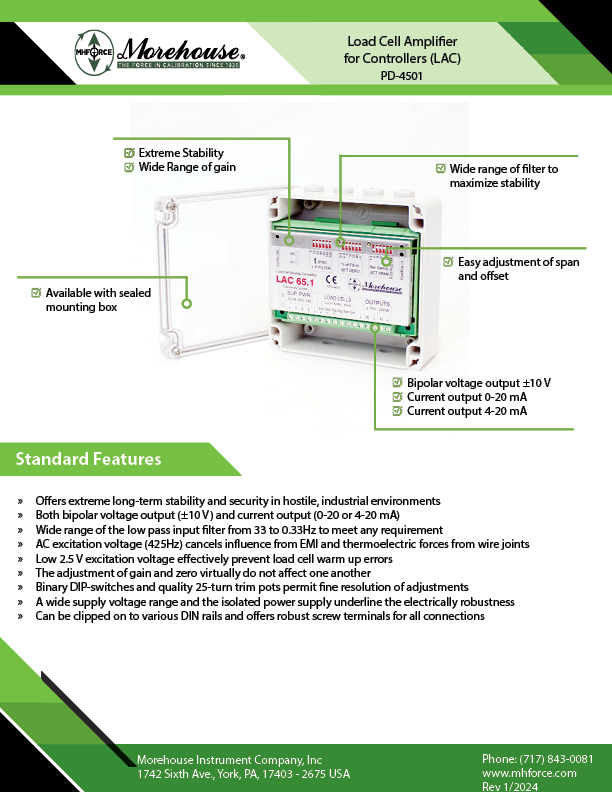Amplified Load Cells (4-20mA, 0 -10 VDC)
Amplified load cells are specialized force measurement devices that integrate a built-in signal conditioning system, outputting a standardized 4-20mA or 0-10VDC signal.
These load cells are widely used in industrial applications where robust, noise-resistant, and long-distance transmission is required.
Unlike traditional load cells, which output a low-level millivolt signal (mV/V) requiring external amplification, amplified load cells provide a conditioned and stable signal directly compatible with PLCs, data acquisition systems, and process controllers.
Amplified load cells are commonly used in industrial weighing systems, measuring force in hopper scales, tank weighing, and conveyor belts.
In process control and automation, they ensure precise force monitoring in hydraulic presses, robotic arms, and material testing machines.
Structural monitoring helps evaluate stress in bridges and infrastructure to prevent failures. Additionally, they play a crucial role in medical and aerospace applications, providing force feedback in prosthetics, aircraft component testing, and medical devices.
As discussed earlier, load cells function based on strain gauge technology, where mechanical force deforms a metal element, altering its electrical resistance. This change is converted into an electrical signal, which in a standard load cell is a small millivolt output. In amplified load cells, an integrated signal conditioner boosts this weak signal to a more robust 4-20mA or 0-10VDC output.
- 4-20mA Output: Current loop transmission is widely used in industrial automation because it is less susceptible to signal loss and electrical noise, making it ideal for long-distance wiring applications.
- 0-10VDC Output: Voltage output is often used in applications requiring simple integration with analog input devices like controllers and indicators. However, it is more susceptible to voltage drops over long cable runs.
Considerations When Selecting an Amplified Load Cell
Output Type: Choose 4-20mA for long-distance, noise-resistant applications and 0-10VDC for shorter connections with minimal interference.
- Load Capacity: Ensure the load cell is rated for the expected force range to prevent overloading.
- Environmental Factors: Look for IP-rated enclosures for protection against dust, moisture, and extreme temperatures.
- Accuracy Requirements: Verify the specifications meet your needs. Often the end-user will sacrifice accuracy requirement when selecting an amplified load cell. In our experience the repeatability of many amplified load cells is much less than that of a regular load cell system. We have one exception in our Morehouse LAC amplified.
Load Cell Amplifier for Controllers (LAC) Performance Test
Morehouse has a solution if you want the best and do not want to buy an amplified load cell.
Morehouse has searched for a suitable amplifier for load cells capable of generating 4-20 mA scale and 0-10 V scale outputs. In our search, we discovered most amplifiers were not very stable.
The resolution was four decimal places at best, and most were only stable to 3 decimal places. If you are concerned with TUR and meeting a tolerance, this lack of stability and/or resolution is a very dominant contributor to your overall uncertainty.
This impacts the calibration uncertainties. Furthermore, an unstable amplifier can drastically undermine the performance of a load cell and lower the measurement quality even though the user has invested in acquiring a high-quality load cell. In summary, the best way to evaluate the performance of an amplified load cell system is to consider all the influencing factors and evaluate the overall performance of the system.
To evaluate the performance of Morehouse LAC amplifiers, a 10,000 lbf Morehouse shear web load cell was coupled with an amplifier and calibrated in our 12,000 lbf deadweight frame at various test points.
The amplifier was set to generate an output of 4-20 mA for the range of load cell capacity. The output of the amplifier was then read at each load point to the last most stable digit.
This test was conducted following the ASTM E74 procedure, and load cell performance factors such as lower limit factor (LLF) and class A loading range were determined based on the obtained data.
LLF is the expected performance of the device. Most of the amplifiers available on the market gave us an overall LLF accuracy of 0.02 % of full scale.
However, the Load Cell Amplifier for Controllers (LAC) allowed us to read to 5 decimals on this 10000 lbf load cells, and the overall accuracy was better than 0.005 % of full scale. The figure below displays the results of the load cell amplifier system calibration and resulting accuracy values.

Figure 1 ASTM E74 Calibration Results for 10,000 lbf Load Cell System with LAC
At this point, we knew we had to test another one.
We did the second test on a 1000 lbf Morehouse Ultra-Precision Load Cell, which proved conclusive.
The above figure contains the calibration results for the 1000 lbf load cell system with LAC. Furthermore, Figure 1 demonstrates the non-linearity analysis performed on the 1000 lbf load cell.
The maximum non-linearity observed was around 0.007 % of the full-scale output. The Morehouse Ultra-Precision Load Cell's rated non-linearity is 0.02 % FS.
This test proved that LAC did not undermine the performance of the load cell system with regard to non-linearity.
Figure 2 ASTM E74 Calibration Results for 10,000 lbf Load Cell System with LAC

Figure 3 Non-Linearity Analysis of the 1000 lbf Load Cell System with LAC (This is much better than any amplified load cell we have seen)
Figure 4 Morehouse LAC 65.1 for Amplified Load Cells Specifications
By conducting this set of performance tests, we finally found a load cell amplifier that would not degrade the accuracy of the load cell. We are very pleased to add the Morehouse LAC to our product line.
This exceptionally stable amplifier with high versatility can help make your industrial control or automation system more effective.
It offers bipolar voltage output ±10V, and current output 0-20 or 4-20mA.
It can drive up to 8 Pc 350-ohm load cells and features a wide voltage range and isolated power supply. More information on our new LAC amplifier can be found on LAC webpage.
More Information about Morehouse
We believe in changing how people think about Force and Torque calibration in everything we do. That includes finding the best alternative to buying an amplified load cell.
This includes setting expectations and challenging the "just calibrate it" mentality by educating our customers on what matters and what may cause significant errors.
We focus on reducing these errors and making our products simple and user-friendly.
This means your instruments will pass calibration more often and produce more precise measurements, giving you the confidence to focus on your business.
Companies around the globe rely on Morehouse for accuracy and speed.
Our measurement uncertainties are 10-50 times lower than the competition, providing you with more accuracy and precision in force measurement.
We turn around your equipment in 7-10 business days so you can return to work quickly and save money.
When you choose Morehouse, you're not just paying for a calibration service or a load cell.
You're investing in peace of mind, knowing your equipment is calibrated accurately and on time.
Through Great People, Great Leaders, and Great Equipment, we empower organizations to make Better Measurements that enhance quality, reduce risk, and drive innovation.
With over a century of experience, we're committed to raising industry standards, fostering collaboration, and delivering exceptional calibration solutions that build a safer, more accurate future.
Contact Morehouse at info@mhforce.com to learn more about our calibration services and load cell products.
Email us if you ever want to chat or have questions about a blog.
We love talking about this stuff. We have many more topics other than expressing SI units!
Our YouTube channel has videos on various force and torque calibration topics here.




